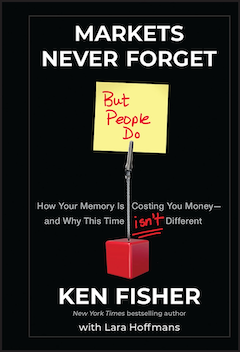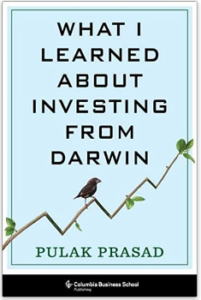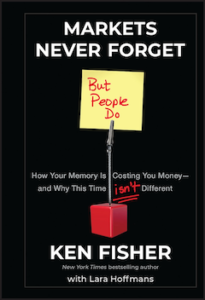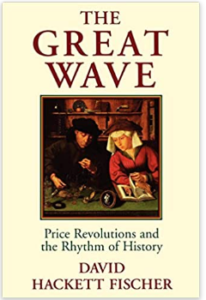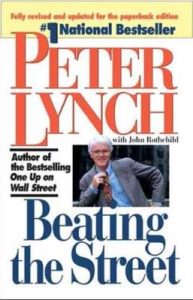By Peter Lynch, Jan/1989(318p.)
Written in the 1980s by the fabled Fidelity portfolio manager, this book was responsible for sparking my interest in fund management. At the time I first read it, I was still in graduate school, preparing for a career in Aerospace Engineering. I believed then in Lynch’s argument that, “anyone could do it,” and I took the plunge by opened an e-trade account in my mid-20s. At 52 years and still doing it, I have come to respect experience and long track records more than I used to when I was younger. That said, I agree with what Gautam Baid stated in his book, The Joys of Compounding (Victori review): “Knowledge comes from experience, but it doesn’t have to be your experience.”
Lynch is famous to this day for having one of the best track records in the business. He put up an annualize return of 29% from the late-1970s, when he was in his mid-20s, through his retirement in 1991, at just 46. Tragically, Fidelity found that the average investor in Lynch’s fund actually lost money because they redeemed in periods of underperformance. But at least they did better than the investors who chased high flyers from the previous generation. Kenneth Heebner, for example, ranked as America’s No. 1 fund manager in the 1990s before losing his touch and most of his assets. According to one article from 2013 (link), the then-71 year old manager never lost his swagger after ranking at the bottom of his peer group by losing 6% on average in the decade through 2007. This other article from 2008 (link) reports that the “legendary fund manager goes from penthouse to outhouse,” and this one from 2016 (link) says Heebner’s “venerable Boston mutual fund shut its doors after 48 years.” Go back another generation (to the 1960s Go-Go years), and there are even more glaring examples of Wall Street’s proclivity for roadkill, including Gerald Tsai (Wikipedia link), who helped build Fidelity into the behemoth it is today, but his fund, which was packed with the glamour stocks of the day, lost 90% of its value in 1969. After that, Tsai left Fidelity and started his own fund, Tsai Management, but in 1973 sold the firm and retired. Later Tsai resurfaced as the CEO of American Can Company, so I am sure he did ok. The bottom line is that Lynches best trade ever may have been to exit the business while he was still on top.

One of the key lessons I learned from Lynch’s story and that of other Wall Street legends is that it not only pays to avoid glamour stocks, but also the glamour managers. As I look around today, I see some highly successful, and still young, glamour-stock fund managers who would probably do best to follow Lynch’s example of leaving while the going is still good. At the end of the book Lynch offers a list of analysts and fund managers of his time. I highlighted these two lists and reproduced it below because I was impressed by how few of the names I know. While it was before my time, it reminded me of an old saying my late father in law often uttered: “The cemetery is full of irreplaceable people.” By extrapolation, I’d say that if there were a cemetery for Wall Street firms, it would also be packed.
One Up on Wall Street has become timeless for its classic one-liners. Phrases like “dumb money is only dumb when it listens to the smart money,” or “Investing without research is like playing stud poker and never looking at the cards,” or “you don’t have to kiss all the girls,” remain lexicons to this day. Here are my top 5, but I underlined dozens in the highlighted passages below:
- “It’s obvious that studying history and philosophy was much better preparation for the stock market than, say, studying statistics.”
- “When in doubt, tune in later.”
- “Sometime in the next month, year, or three years, the market will decline sharply.”
- “Selling an outstanding fast grower because its stock seems slightly overpriced is a losing technique.”
- “I hear every day that AIDS will do us in, the drought will do us in, inflation will do us in, recession will do us in, the budget deficit will do us in, the trade deficit will do us in, and the weak dollar will do us in. Whoops. Make that the strong dollar will do us in. They tell me real estate prices are going to collapse. Last month people started worrying about that. This month they’re worrying about the ozone layer. If you believe the old investment adage that the stock market climbs a “wall of worry,” take note that the worry wall is fairly good-sized now and growing every day.”
My favorite part though, was the list of twelve silliest (and most dangerous) things people say about stocks:
- IF IT’S GONE DOWN THIS MUCH ALREADY, IT CAN’T GO MUCH LOWER
- YOU CAN ALWAYS TELL WHEN A STOCK’S HIT BOTTOM
- IF IT’S GONE THIS HIGH ALREADY, HOW CAN IT POSSIBLY GO HIGHER?
- IT’S ONLY $3 A SHARE: WHAT CAN I LOSE?
- EVENTUALLY THEY ALWAYS COME BACK
- IT’S ALWAYS DARKEST BEFORE THE DAWN
- WHEN IT REBOUNDS TO $10, I’LL SELL
- WHAT ME WORRY? CONSERVATIVE STOCKS DON’T FLUCTUATE MUCH
- IT’S TAKING TOO LONG FOR ANYTHINGTO EVER HAPPEN
- LOOK AT ALL THE MONEY I’VE LOST: I DIDN’T BUY IT!
- I MISSED THAT ONE, I’LL CATCH THE NEXT ONE
- THE STOCK’S GONE UP, SO I MUST BE RIGHT, OR . . . THE STOCK’S GONE DOWN SO I MUST BE WRONG
Incidentally, Lynch mentions hedge fund manager Robert Wilson in the body of the book, but only as part of his criticism of short selling. Wilson isn’t even included in Lynches fund manager list, which is not fair. While Lynch’s 22-year career of annualized returns in the high 20s (pre-tax) during the great bull market of the 1980s is undoubtedly impressive, Roemer McPhee’s book, Killing the Market (Victori review), claims Wilson compounded his net worth (after tax) at an astonishing annual rate of 35% in 14 years (1963-1977), which encompassed the 1969 growth crash that killed Tsai and the inflation scare of the 1970s that killed many more. Moreover, before Wilson died at 2013 at 87, he gave all his money away, over $800 million. According to Wealthy Persons (link), a website focused on Celebrities, Lynch turned only 77 in January 2021, weighs only 180 pounds, and has a net worth of only $450 million. Moreover, the Lynch Foundation, gave away only $8 million in 2013. The Foundation supports education, religious, cultural, and historic organizations, plus hospitals and medical research. While that too is impressive, Wilson is said to have given away more than $600 million to environmental preservation organizations, including Nature Conservancy and the World Momentus Fund. Born in 1926 and more frugal than Buffett, Wilson once told a reporter that “one of the dumbest things you can do with money is spend it.” May he rest in peace.
In conclusion, even though Peter Lynch’s book was written more than three decades ago, and even though the fund management business has changed dramatically since ETFs were introduced in the 1990s, it is definitely a worthwhile read. It shows how some things never really change, and it offers one of the best collection of stock stories I have come across. For those interested in investing who have not read it, or have read it only once a long time ago, I recommend it.
Best regards,
Adriano
Highlighted Passages:
Introduction to the Millennium Edition
Never before has the market recorded more than two back-to-back 20 percent gains.
All along I’ve been technophobic. My experience shows you don’t have to be trendy to succeed as an investor. In fact, most great investors I know (Warren Buffett, for starters) are technophobes. They don’t own what they don’t understand, and neither do I. I understand Dunkin’ Donuts and Chrysler, which is why both inhabited my portfolio. I understand banks, savings-and-loans, and their close relative, Fannie Mae. I don’t visit the Web. I’ve never surfed on it or chatted across it. Without expert help (from my wife or my children, for instance) I couldn’t find the Web.
To my mind, the stock price is the least useful information you can track, and it’s the most widely tracked. When One Up was written in 1989, a lone ticker tape ran across the bottom of the Financial News Network.
Prologue: A Note from Ireland
I’ve always believed that investors should ignore the ups and downs of the market.
When you sell in desperation, you always sell cheap.
To all the dozens of lessons we’re supposed to have learned from October, I can add three: (1) don’t let nuisances ruin a good portfolio; (2) don’t let nuisances ruin a good vacation; and (3) never travel abroad when you’re light on cash.
prefer to write about something you might find more valuable: how to identify the superior companies. Whether it’s a 508-point day or a 108-point day, in the end, superior companies will succeed and mediocre companies will fail, and investors in each will be rewarded accordingly.
Introduction: The Advantages of Dumb Money
But rule number one, in my book, is: Stop listening to professionals! Twenty years in this business convinces me that any normal person using the customary three percent of the brain can pick stocks just as well, if not better, than the average Wall Street expert.
Dumb money is only dumb when it listens to the smart money.
In my business a fourbagger is nice, but a tenbagger is the fiscal equivalent of two home runs a
The first stock I ever bought, Flying Tiger Airlines, turned out to be a multibagger that put me through graduate school.
The effect is most striking in weak stock markets—yes, there are tenbaggers in weak markets.
The more right you are about any one stock, the more wrong you can be on all the others and still triumph as an investor.
Part I: Preparing to Invest
There’s no such thing as a hereditary knack for picking stocks.
The Lynch Law, closely related to the Peter Principle, states: Whenever Lynch advances, the market declines.
Distrust of stocks was the prevailing American attitude throughout the 1950s and into the 1960s, when the market tripled and then doubled again. This period of my childhood, and not the recent 1980s, was truly the greatest bull market in history, but to hear it from my uncles, you’d have thought it was the craps game behind the pool hall. “Never get involved in the market,” people warned. “It’s too risky. You’ll lose all your money.”
As I look back on it now, it’s obvious that studying history and philosophy was much better preparation for the stock market than, say, studying statistics. Investing in stocks is an art, not a science, and people who’ve been trained to rigidly quantify everything have a big disadvantage.
As for Will Rogers, he may have given the best bit of advice ever uttered about stocks: “Don’t gamble; take all your savings and buy some good stock and hold it till it goes up, then sell it. If it don’t go up, don’t buy it.”
To the list of famous oxymorons—military intelligence, learned professor, deafening silence, and jumbo shrimp—I’d add professional investing.
“Gentlemen prefer bonds.”—Andrew Mellon
Is This a Good Market? Please Don’t Ask
During every question-and-answer period after I give a speech, somebody stands up and asks me if we’re in a good market or a bad market.
I always tell them the only thing I know about predicting markets is that every time I get promoted, the market goes down. As soon as those words are launched from my lips, somebody else stands up and asks me when I’m due for another promotion.
Obviously you don’t have to be able to predict the stock market to make money in stocks, or else I wouldn’t have made any money.
Since the stock market is in some way related to the general economy, one way that people try to outguess the market is to predict inflation and recessions, booms and busts, and the direction of interest rates. True, there is a wonderful correlation between interest rates and the stock market, but who can foretell interest rates with any bankable regularity?
Of course, I’d love to be warned before we do go into a recession, so I could adjust my portfolio. But the odds of my figuring it out are nil. Some people wait for these bells to go off, to signal the end of a recession or the beginning of an exciting new bull market. The trouble is the bells never go off. Remember, things are never clear until it’s too late.
THE COCKTAIL THEORY If professional economists can’t predict economies and professional forecasters can’t predict markets, then what chance does the amateur investor have? You know the answer already, which brings me to my own “cocktail party” theory of market forecasting,
In the first stage of an upward market—one that has been down awhile and that nobody expects to rise again—people aren’t talking about stocks. In fact, if they lumber up to ask me what I do for a living, and I answer, “I manage an equity mutual fund,” they nod politely and wander away.
Stage two: When ten people would rather talk to a dentist about plaque than to the manager of an equity mutual fund about stocks, it’s likely that the market is about to turn up. In stage two, after I’ve confessed what I do for a living, the new acquaintances linger a bit longer—perhaps long enough to tell me how risky the stock market is—before they move over to talk to the dentist. The cocktail party talk is still more about plaque than about stocks. The market’s up 15 percent from stage one, but few are paying attention.
In stage three, with the market up 30 percent from stage one, a crowd of interested parties ignores the dentist and circles around me all evening.
In stage four, once again they’re crowded around me—but this time it’s to tell me what stocks I should buy. Even the dentist has three or four tips, and in the next few days I look up his recommendations in the newspaper and they’ve all gone up.
Part II: Picking Winners
Investing without research is like playing stud poker and never looking at the cards.
THE SIX CATEGORIES Once I’ve established the size of the company relative to others in a particular industry, next I place it into one of six general categories: slow growers, stalwarts, fast growers, cyclicals, asset plays, and turnarounds.
THE SLOW GROWERS Usually these large and aging companies are expected to grow slightly faster than the gross national product. Slow growers didn’t start out that way. They started out as fast growers and eventually pooped out, either because they had gone as far as they could, or else they got too tired to make the most of their chances. When an industry at large slows down (as they always seem to do), most of the companies within the industry lose momentum as well. Electric utilities are today’s most popular slow growers, but throughout the 1950s and into the 1960s the utilities were fast growers, expanding at over twice the rate of GNP.
In the 1970s, as the cost of power rose sharply, consumers learned to conserve electricity, and the utilities lost their momentum.
Now even computers are slowing down, at least in the mainframe and minicomputer parts of the business. IBM and Digital may be the slow growers of tomorrow.
THE STALWARTS Stalwarts are companies such as Coca-Cola, Bristol-Myers, Procter and Gamble, the Bell telephone sisters, Hershey’s, Ralston Purina, and Colgate-Palmolive.
THE FAST GROWERS These are among my favorite investments: small, aggressive new enterprises that grow at 20 to 25 percent a year. If you choose wisely, this is the land of the 10- to 40-baggers, and even the 200-baggers. With a small portfolio, one or two of these can make a career.
I’ve already mentioned how electric utilities, especially the ones in the Sunbelt, went from being fast growers to being slow growers. In the 1960s plastics was a high-growth industry. Plastics were so much on people’s minds that when the word “plastics” was whispered to Dustin Hoffman in the movie The Graduate, the word itself became a famous line.
THE CYCLICALS A cyclical is a company whose sales and profits rise and fall in regular if not completely predictable fashion. In a growth industry, business just keeps expanding, but in a cyclical industry it expands and contracts, then expands and contracts again.
Cyclicals are the most misunderstood of all the types of stocks. It is here that the unwary stockpicker is most easily parted from his money, and in stocks that he considers safe.
Timing is everything in cyclicals, and you have to be able to detect the early signs that business is falling off or picking up. If you work in some profession that’s connected to steel, aluminum, airlines, automobiles, etc., then you’ve got your edge, and nowhere is it more important than in this kind of investment.
TURNAROUNDS Turnaround candidates have been battered, depressed, and often can barely drag themselves into Chapter 11.
There’s the restructuring-to-maximize-shareholder-values kind of turnaround, such as Penn Central. Wall Street seems to favor restructuring these days, and any director or CEO who mentions it is warmly applauded by shareholders. Restructuring is a company’s way of ridding itself of certain unprofitable subsidiaries it should never have acquired in the first place. The earlier buying of these ill-fated subsidiaries, also warmly applauded, is called diversification. I call it diworseification.
THE ASSET PLAYS An asset play is any company that’s sitting on something valuable that you know about, but that the Wall Street crowd has overlooked. With so many analysts and corporate raiders snooping around, it doesn’t seem possible that there are any assets that Wall Street hasn’t noticed, but believe me, there are. The asset play is where the local edge can be used to greatest advantage.
HIGHFLIERS TO LOW RIDERS Companies don’t stay in the same category forever.
Advanced Micro Devices and Texas Instruments, once champion fast growers, are now regarded as cyclicals.
Getting the story on a company is a lot easier if you understand the basic business.
If it’s a choice between owning stock in a fine company with excellent management in a highly competitive and complex industry, or a humdrum company with mediocre management in a simpleminded industry with no competition, I’d take the latter. For
You never find the perfect company, but if you can imagine it, then you’ll know how to recognize favorable attributes, the most important thirteen of which are as follows: (1) IT SOUNDS DULL—OR, EVEN BETTER, RIDICULOUS The perfect stock would be attached to the perfect company, and the perfect company has to be engaged in a perfectly simple business, and the perfectly simple business ought to have a perfectly boring name. The more boring it is, the better.
(2) IT DOES SOMETHING DULL I get even more excited when a company with a boring name also does something boring. Crown, Cork, and Seal makes cans and bottle caps. What could be duller than that? You won’t see an interview with the CEO of Crown, Cork, and Seal in Time magazine alongside an interview with Lee Iacocca, but that’s a plus. There’s nothing boring about what’s happened to the shares of Crown, Cork, and Seal.
(3) IT DOES SOMETHING DISAGREEABLE Better than boring alone is a stock that’s boring and disgusting at the same time. Something that makes people shrug, retch, or turn away in disgust is ideal. Take Safety-Kleen. That’s a name with promise to begin with—any company that uses a k where there ought to be a c is worth investigating. The fact that Safety-Kleen was once related to Chicago Rawhide is also favorable (see “It’s a Spinoff” later in this chapter).
(4) IT’S A SPINOFF Spinoffs of divisions or parts of companies into separate, freestanding entities—such as Safety-Kleen out of Chicago Rawhide or Toys “R” Us out of Interstate Department Stores—often result in astoundingly lucrative investments.
(5) THE INSTITUTIONS DON’T OWN IT, AND THE ANALYSTS DON’T FOLLOW IT If you find a stock with little or no institutional ownership, you’ve found a potential winner.
(9) IT’S GOT A NICHE I’d much rather own a local rock pit than own Twentieth Century-Fox, because a movie company competes with other movie companies, and the rock pit has a niche. Twentieth Century-Fox understood that when it bought up Pebble Beach, and the rock pit with it.
(10) PEOPLE HAVE TO KEEP BUYING IT I’d rather invest in a company that makes drugs, soft drinks, razor blades, or cigarettes than in a company that makes toys. In the toy industry somebody can make a wonderful doll that every child has to have, but every child gets only one each. Eight months later that product is taken off the shelves to make room for the newest doll the children have to have—manufactured by somebody else.
(11) IT’S A USER OF TECHNOLOGY Instead of investing in computer companies that struggle to survive in an endless price war, why not invest in a company that benefits from the price war—such as Automatic Data Processing?
(12) THE INSIDERS ARE BUYERS There’s no better tip-off to the probable success of a stock than that people in the company are putting their own money into it. In general, corporate insiders are net sellers, and they normally sell 2.3 shares to every one share that they buy.
Stocks I’d Avoid: If I could avoid a single stock, it would be the hottest stock in the hottest industry, the one that gets the most favorable publicity, the one that every investor hears about in the car pool or on the commuter train—and succumbing to the social pressure, often buys.
BEWARE THE NEXT SOMETHING Another stock I’d avoid is a stock in a company that’s been touted as the next IBM, the next McDonald’s, the next Intel, or the next Disney, etc.
BEWARE THE WHISPER STOCK I get calls all the time from people who recommend solid companies for Magellan, and then, usually after they’ve lowered their voices as if to confide something personal, they add: “There’s this great stock I want to tell you about. It’s too small for your fund, but you ought to look at it for your own account. It’s a fascinating idea, and it could be a big winner.”
BEWARE THE MIDDLEMAN The company that sells 25 to 50 percent of its wares to a single customer is in a precarious situation. SCI Systems (not to be confused with the funeral-home firm) is a well-managed company and a major supplier of computer parts to IBM, but you never know when IBM will decide that it can make its own parts, or that it can do without the parts, and then cancel the SCI contract.
When you buy a stock in a fast-growing company, you’re really betting on its chances to earn more money in the future.
Here are some pointers from this section:
- Understand the nature of the companies you own and the specific reasons for holding the stock. (“It is really going up!” doesn’t count.)
- By putting your stocks into categories you’ll have a better idea of what to expect from them.
- Big companies have small moves, small companies have big moves.
- Consider the size of a company if you expect it to profit from a specific product.
- Look for small companies that are already profitable and have proven that their concept can be replicated.
- Be suspicious of companies with growth rates of 50 to 100 percent a year.
- Avoid hot stocks in hot industries.
- Distrust diversifications, which usually turn out to be diworseifications.
- Long shots almost never pay off.
- It’s better to miss the first move in a stock and wait to see if a company’s plans are working out.
- People get incredibly valuable fundamental information from their jobs that may not reach the professionals for months or even years.
- Separate all stock tips from the tipper, even if the tipper is very smart, very rich, and his or her last tip went up.
- Some stock tips, especially from an expert in the field, may turn out to be quite valuable. However, people in the paper industry normally give out tips on drug stocks, and people in the health care field never run out of tips on the coming takeovers in the paper industry.
- Invest in simple companies that appear dull, mundane, out of favor, and haven’t caught the fancy of Wall Street.
- Moderately fast growers (20 to 25 percent) in nongrowth industries are ideal investments.
- Look for companies with niches.
- When purchasing depressed stocks in troubled companies, seek out the ones with the superior financial positions and avoid the ones with loads of bank debt.
- Companies that have no debt can’t go bankrupt.
- Managerial ability may be important, but it’s quite difficult to assess. Base your purchases on the company’s prospects, not on the president’s resume or speaking ability.
- A lot of money can be made when a troubled company turns around.
- Carefully consider the price-earnings ratio. If the stock is grossly overpriced, even if everything else goes right, you won’t make any money.
- Find a story line to follow as a way of monitoring a company’s progress.
- Look for companies that consistently buy back their own shares.
- Study the dividend record of a company over the years and also how its earnings have fared in past recessions.
- Look for companies with little or no institutional ownership.
- All else being equal, favor companies in which management has a significant personal investment over companies run by people that benefit only from their salaries.
- Insider buying is a positive sign, especially when several individuals are buying at once.
- Devote at least an hour a week to investment research. Adding up your dividends and figuring out your gains and losses doesn’t count.
- Be patient. Watched stock never boils.
- Buying stocks based on stated book value alone is dangerous and illusory. It’s real value that counts.
- When in doubt, tune in later.
- Invest at least as much time and effort in choosing a new stock as you would in choosing a new refrigerator.
Part III: The Long-term View
There’s a long-standing debate between two factions of investment advisors, with the Gerald Loeb faction declaring, “Put all your eggs in one basket,” and the Andrew Tobias faction retorting, “Don’t put all your eggs in one basket. It may have a hole in it.”
In my view it’s best to own as many stocks as there are situations in which: (a) you’ve got an edge; and (b) you’ve uncovered an exciting prospect that passes all the tests of research. Maybe that’s a single stock, or maybe it’s a dozen stocks.
That said, it isn’t safe to own just one stock, because in spite of your best efforts, the one you choose might be the victim of unforeseen circumstances. In small portfolios I’d be comfortable owning between three and ten stocks.
Some people automatically sell the “winners”—stocks that go up—and hold on to their “losers”—stocks that go down—which is about as sensible as pulling out the flowers and watering the weeds. Others automatically sell their losers and hold on to their winners, which doesn’t work out much better. Both strategies fail because they’re tied to the current movement of the stock price as an indicator of the company’s fundamental value.
If you can’t convince yourself “When I’m down 25 percent, I’m a buyer” and banish forever the fatal thought “When I’m down 25 percent, I’m a seller,” then you’ll never make a decent profit in stocks.
WHEN TO SELL Even the most thoughtful and steadfast investor is susceptible to the influence of skeptics who yell “Sell” before it’s time to sell. I ought to know. I’ve been talked out of a few tenbaggers myself.
WHEN TO SELL A SLOW GROWER I can’t really help you with this one, because I don’t own many slow growers in the first place.
Here are some other signs:
- The company has lost market share for two consecutive years and is hiring another advertising agency.
- No new products are being developed, spending on research and development is curtailed, and the company appears to be resting on its laurels.
- Two recent acquisitions of unrelated businesses look like diworseifications, and the company announces it is looking for further acquisitions “at the leading edge of technology.”• The company has paid so much for its acquisitions that the balance sheet has deteriorated from no debt and millions in cash to no cash and millions in debt. There are no surplus funds to buy back stock, even if the price falls sharply.
- Even at a lower stock price the dividend yield will not be high enough to attract much interest from investors.
WHEN TO SELL A CYCLICAL The best time to sell is toward the end of the cycle, but who knows when that is? Who even knows what cycles they’re talking about? Sometimes the knowledgeable vanguard begins to sell cyclicals a year before there’s a single sign of a company’s decline. The stock price starts to fall for apparently no earthly reason. To play this game successfully you have to understand the strange rules. That’s what makes cyclicals so tricky. In the defense business, which behaves like a cyclical, the price of General Dynamics once fell 50 percent on higher earnings. Farsighted cycle-watchers were selling in advance to avoid the rush. Other than at the end of the cycle, the best time to sell a cyclical is when something has actually started to go wrong. Costs have started to rise.
One obvious sell signal is that inventories are building up and the company can’t get rid of them, which means lower prices and lower profits down the road.
Falling commodity prices is another harbinger.
Final demand for the product is slowing down.
The company has tried to cut costs but still can’t compete with foreign producers.
WHEN TO SELL A FAST GROWER Here, the trick is not to lose the potential tenbagger. On the other hand, if the company falls apart and the earnings shrink, then so will the p/e multiple that investors have bid up on the stock. This is a very expensive double whammy for the loyal shareholders.
I’m constantly amazed at popular explanations of why stocks behave the way they do, which are volunteered by amateurs and professionals alike. We’ve made great advances in eliminating ignorance and superstition in medicine and in weather reports, we laugh at our ancestors for blaming bad harvests on corn gods, and we wonder, “How could a smart man like Pythagoras think that evil spirits hide in rumpled bedsheets?” However, we’re perfectly willing to believe that who wins the Super Bowl might have something to do with stock prices.
The Twelve Silliest (and Most Dangerous) Things People Say About Stock Prices
IF IT’S GONE DOWN THIS MUCH ALREADY, IT CAN’T GO MUCH LOWER
YOU CAN ALWAYS TELL WHEN A STOCK’S HIT BOTTOM
IF IT’S GONE THIS HIGH ALREADY, HOW CAN IT POSSIBLY GO HIGHER?
IT’S ONLY $3 A SHARE: WHAT CAN I LOSE?
EVENTUALLY THEY ALWAYS COME BACK
IT’S ALWAYS DARKEST BEFORE THE DAWN
WHEN IT REBOUNDS TO $10, I’LL SELL
WHAT ME WORRY? CONSERVATIVE STOCKS DON’T FLUCTUATE MUCH
IT’S TAKING TOO LONG FOR ANYTHINGTO EVER HAPPEN
LOOK AT ALL THE MONEY I’VE LOST: I DIDN’T BUY IT!
I MISSED THAT ONE, I’LL CATCH THE NEXT ONE
THE STOCK’S GONE UP, SO I MUST BE RIGHT, OR . . . THE STOCK’S GONE DOWN SO I MUST BE WRONG
…you can’t actually spend the proceeds you get from shorting a stock until you’ve paid the shares back and closed out the transaction.
The scary part about shorting stock is that even if you’re convinced that the company’s in lousy shape, other investors might not realize it and might even send the stock price higher.
Among all the folk tales of successful short sellers are the horror stories of shorters who watched helplessly as their favorite lousy stocks soared higher and higher, against all reason and logic, forcing them into the poorhouse. One such unfortunate was Robert Wilson, a smart man and a good investor, who a decade or so ago shorted Resorts International. He was right, eventually—most shorters are right, eventually—didn’t John Maynard Keynes say in the long run “we all are dead”? In the meantime, however, the stock advanced from 70 cents to $70, a modest 100-bagger, leaving Mr. Wilson with a modest $20 or $30 million loss.
This demonstrates that the market, like individual stocks, can move in the opposite direction of the fundamentals over the short term,
I hear every day that major companies are going out of business. Certainly some of them are. But what about the thousands of smaller companies that are coming into business and providing millions of new jobs? As I make my usual rounds of various headquarters, I’m amazed to discover that many companies are still going strong. Some are actually earning money. If we’ve lost all sense of enterprise and will to work, then who are those people who seem to be stuck in rush hour?
I hear every day that AIDS will do us in, the drought will do us in, inflation will do us in, recession will do us in, the budget deficit will do us in, the trade deficit will do us in, and the weak dollar will do us in. Whoops. Make that the strong dollar will do us in. They tell me real estate prices are going to collapse. Last month people started worrying about that. This month they’re worrying about the ozone layer. If you believe the old investment adage that the stock market climbs a “wall of worry,” take note that the worry wall is fairly good-sized now and growing every day.
If you take anything with you at all from this last section, I hope you’ll remember the following:
- Sometime in the next month, year, or three years, the market will decline sharply.
- Market declines are great opportunities to buy stocks in companies you like. Corrections—Wall Street’s definition of going down a lot—push outstanding companies to bargain prices.
- Trying to predict the direction of the market over one year, or even two years, is impossible.
- It takes years, not months, to produce big results.
- Different categories of stocks have different risks and rewards.
- Stock prices often move in opposite directions from the fundamentals but long term, the direction and sustainability of profits will prevail.
- Just because a company is doing poorly doesn’t mean it can’t do worse.
- Just because the price goes up doesn’t mean you’re right.
- Just because the price goes down doesn’t mean you’re wrong.
- Buying a company with mediocre prospects just because the stock is cheap is a losing technique.
- Selling an outstanding fast grower because its stock seems slightly overpriced is a losing technique.
- Companies don’t grow for no reason, nor do fast growers stay that way forever.
- You don’t lose anything by not owning a successful stock, even if it’s a tenbagger.
- A stock does not know that you own it.
- Don’t become so attached to a winner that complacency sets in and you stop monitoring the story.
- You won’t improve results by pulling out the flowers and watering the weeds.
- There is always something to worry about.
- You don’t have to “kiss all the girls.”
Analyst List
John Adams, Adams, Harkness & Hill
Mike Armellino, Goldman, Sachs & Co.
Steve Berman
Allan Bortel
Jon Burke
Norm Caris, Gruntal & Co.
Tom Clephane, Morgan Stanley & Co.
Art Davis Don DeScenza (deceased), Nomura Securities
David Eisenberg, Sanford Bernstein
Jerry Epperson
Joe Frazzano
Dick Fredericks
Jonathan Gelles
Jane Gilday, McKinley
Allsopp Maggie
Gilliam Tom
Hanley Herb Hardt, Monness, Crespi, Hardt & Co., Inc.
Brian Harra, Brean Murray, Foster Securities
Ira Hirsch, The Fourteen Research Corp.
Ed Hyman
Sam Isaly
Lee Isgur
Robert Johnson
Joe Jolson
Paul Keleher
John Kellenyi
Dan Lee
Bob Maloney, Wood Gundy Corp.
Peter Marcus
Jay Meltzer, Goldman Sachs & Co.
Tom Petrie
Larry Rader
Tom Richter, Robinson Humphrey
Bill Ritger, Dillon Reed & Co.
Elliot Schlang
Elliot Schneider, Gruntal & Co.
Rick Schneider
Don Sinsabaugh, Swergold, Chefitz & Sinsabaugh
Stein Soelberg, Baird, Patrick & Co.
Oakes Spalding
Stewart Spector
Joseph Stechler, Stechler & Co.
Jack Sullivan (deceased), Van Kasper & Co.
David Walsh Skip Wells, Adams, Harkness & Hill
Fund Manager List
James Roger Bacon, Putnam Management
George Boltres, Tiedman, Karlin, Boltres
Tom Cashman, Massachusetts Financial Services
Ken Cassidy, Cassidy Investments
Tony Cope
Richard Corneliuson
Gerald Curtis, Webster Management
Peter deRoetth, Account Management
Tom Duncan, Frontier Capital Management
Charles Flather, Middlegreen Associates
Richard Frucci, Putnam Management
Mario Gabelli, Gabelli & Company
Bob Gintel, Gintel & Company
Dick Goldstein, Richard Goldstein
Investments Jon Gruber, Gruber Capital Management
Paul Haagensen, Putnam Management
Bill Harris (retired), Massachusetts Financial Services
Ken Heebner, Capital Growth Management
Philip Hempleman, Ardsley Partners
Ed Huebner (deceased), Hellman, Jordan Management
Richard Jodka H.
Alden Johnson, Jr. (deceased), Massachusetts Financial Services
Donald Keller, Rollert & Sullivan
David Knight, Knight, Bain, Seath & Holbrook
Kathy Magrath, Valuequest
Terry Magrath, Valuequest
Ed Mathias, The Carlyle Group
Joe McNay, Essex Investment Management
Bill Miller, Legg Mason
Neal Miller, Fidelity
David Mills
Ernest Monrad, Northeast Investors
John Neff (retired), Wellington Management
Michael Price, MFP Investors, LLC
Jimmy Rogers
Binkley Shorts, Wellington Management
Rick Spillane, Eaton Vance (now Fidelity)
Richard Strong, Strong Corneliuson
Eyk Van Otterloo, Grantham, Mayo, Van Otterloo
Ernst H. von Metzch, Wellington Management
Wally Wadman, Constitution Research & Management Inc.
Matt Weatherbie, M.A. Weatherbie & Co., Inc.



